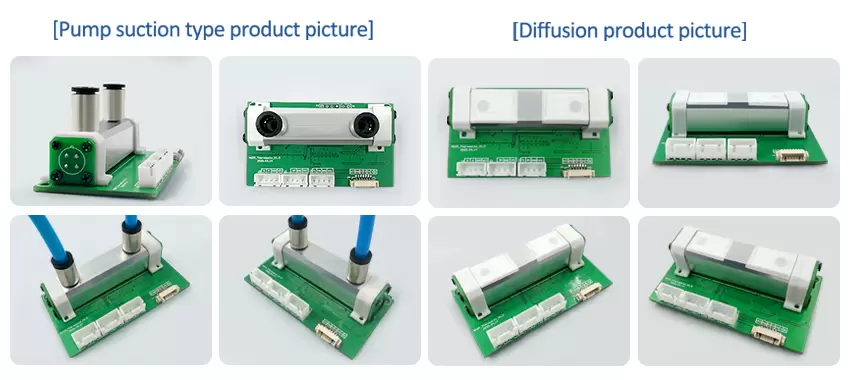This paper describes why an infrared sensor (NDIR sensor) is the preferred option for methane detection, as methane detectors are essential for monitoring safety and efficiency in a wide range of applications.

Gas detectors that can detect and quantify industrial and environmental gases like carbon monoxide, carbon dioxide, and methane play a vital role in ensuring the safety and efficiency of a wide variety of processes and applications. As recently as 30 years ago, miners were still using canaries to warn them of high levels of carbon monoxide or methane present in the mine. Thankfully, sensor technology has now moved on, and there are an ever-increasing number of options available for gas detection.
Gas detectors are widely used to detect leaks and monitor methane concentrations
Natural gas, which mainly consists of methane, is widely used in power generation. However, methane is a greenhouse gas, extremely flammable, and can form explosive mixtures in air. Methane leaks can have devastating results, so detecting leaks is vital during natural gas extraction, transportation, and power generation.
In the chemical industry production of syngas, methanol, acetic acid and other commodity chemicals depend on methane gas sensors to ensure that processes are operating safely and efficiently. Measuring atmospheric levels of methane is also becoming increasingly important for monitoring changing environmental conditions that may affect the environment and human health.
Commercially available gas detection technologies
There are a wide range of commercially available methane gas detectors and sensors, all with their own advantages and disadvantages:
Flame ionized detectors (FIDs)
FIDs use a hydrogen flame to ionize the methane gas. The ionized gas conducts an electrical current, which is measured to determine the gas concentration. Although FIDs are fast and accurate, they require the presence of a hydrogen source, an open flame, and a clean air supply. As a result, FIDs are not suitable for some applications.
Catalytic sensors
Catalytic sensors catalyze the reaction between methane and oxygen, resulting in heat generation and a change in resistance in the sensor, from which the methane concentration can be calculated. Although catalytic sensors are inexpensive and robust, they require the presence of oxygen to operate and are susceptible to poisoning, sintering, and contamination. As a result, regular calibration and replacement is required.
Semiconductor sensors
In a similar manner to catalytic sensors, semiconductor sensors react with methane, causing a change in resistance that is used to calculate the gas concentration. In common with catalytic sensors, semiconductor sensors are prone to contamination and poisoning.
Electrochemical sensors
Electrochemical sensors oxidize or reduce the methane at an electrode to produce a current, which is used to determine the gas concentration. Due to the contact between the atmosphere and the electrode, corrosion and chemical contamination can occur, and electrochemical sensors need frequent replacement.
Infrared Sensor
IR sensors use an IR beam to detect and quantify gases present in the atmosphere. Although infrared sensors are slightly more expensive than some other sensors, they are robust and long-lasting. As a result, infrared sensors have become the dominant technology for detecting a range of gases.

Infrared Sensor (IR sensor) is the technology of choice for methane detection
A nondispersive infrared sensor (NDIR) typically consist of an IR source, a sample chamber, a light filter, and an IR detector. Typically, a second chamber containing a reference gas runs in parallel to the sampling chamber. IR light is directed through the atmospheric sampling chamber to the detector. The methane gas in the sampling chamber absorbs light at specific wavelengths. A filter in front of the detector blocks out light that is not at the desired wavelength, so the detector measures the attenuation at the specified wavelength only, which is used to determine the concentration of methane present.
IR sensors have several advantages over other gas detection technologies: IR sensors have a built-in fail-safe system, which comes from the fact that small signals represent high concentrations of gas, while in other sensors small or no signal means zero or low gas concentrations. If the detector becomes obscured or fails, no IR radiation will register, and an alarm will be raised.
What’s more, unlike other available types of sensors, IR detectors don’t interact with the methane gas. The gas and any contaminants in the atmosphere only interact with a light beam. As a result, the detector is protected from damage and has a long lifespan.
NDIR sensors are also able to be more specific than techniques that require the gas mixture to be burnt. In some cases, NDIR sensors even allow the detection of one flammable gas component in the presence of another. However, this does produce a limitation that users cannot determine whether a gas mixture is flammable or not.
In common with other sensors, IR detectors provide fast response times and accurate results. While catalytic, semiconductor, electrochemical sensors, and FIDs all require the target gas to be present in concentrations below the lower explosion limit, IR sensors can accurately measure gas concentrations of 0-100%. What’s more, IR sensors do not require oxygen or external gases to operate.
IR sensors have some disadvantages; they can be adversely affected by changes in temperature and pressure. However, advanced IR sensors now provide pressure and temperature compensation, resulting in reliable and durable sensors with few drawbacks. IR sensors have become the detection method of choice for methane and other industrially and environmentally relevant gases.
JXCT, a leading supplier of high-quality, low cost gas sensing solutions, provides a comprehensive range of NDIR sensors for reliable carbon dioxide, carbon monoxide, and methane detection.
The NDIR methane sensor is a gas sensor designed for easy integration by original equipment manufacturers into a wide range of systems to provide accurate and reliable measurement of carbon monoxide, carbon dioxide, and methane gas concentrations.
 : +86 155 8830 2704
: +86 155 8830 2704 : jxdziot@gmail.com
: jxdziot@gmail.com
